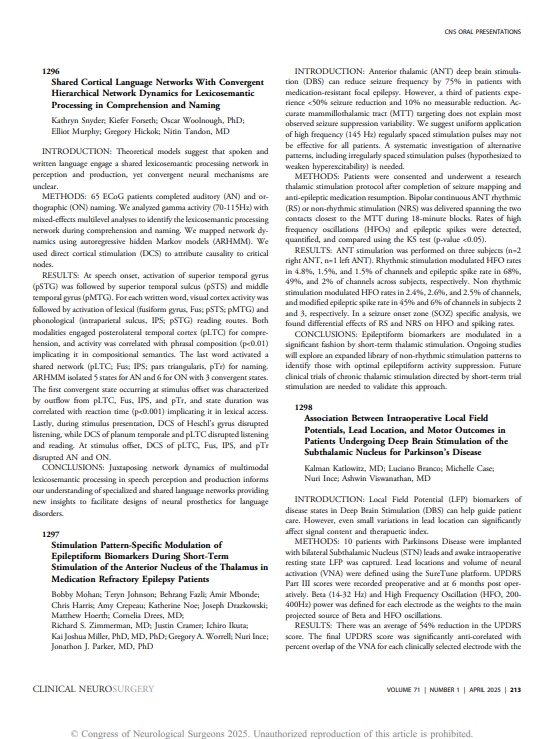Association Between Intraoperative Local Field Potentials, Lead Location, and Motor Outcomes in Patients Undergoing Deep Brain Stimulation of the Subthalamic Nucleus for Parkinson’s Disease
April 2025 | Neurosurgery
Abstract
INTRODUCTION:
Local Field Potential (LFP) biomarkers of disease states in Deep Brain Stimulation (DBS) can help guide patient care. However, even small variations in lead location can significantly affect signal content and therapuetic index.
METHODS:
10 patients with Parkinsons Disease were implanted with bilateral Subthalamic Nucleus (STN) leads and awake intraoperative resting state LFP was captured. Lead locations and volume of neural activation (VNA) were defined using the SureTune platform. UPDRS Part III scores were recorded preoperative and at 6 months post operatively. Beta (14-32 Hz) and High Frequency Oscillation (HFO, 200-400Hz) power was defined for each electrode as the weights to the main projected source of Beta and HFO oscillations.
RESULTS:
There was an average of 54% reduction in the UPDRS score. The final UPDRS score was significantly anti-corelated with percent overlap of the VNA for each clinically selected electrode with the STN (p=0.008 F-test of linear model) but not the Zona Incerta (ZI) (p=0.9). Similarly, Beta and HFO power were significantly higher for electrodes overlapping with the STN (p=0.004 and 0.02, respectively) but not ZI (p>0.4 for both). The UPDRS response corresponded to the maximum amplitude of the Beta power source (p=0.001), but not HFO power (p=0.1). Interestingly, the strength of the pathological cross frequency coupling (CFC) between Beta and HFO oscillations was related to electrode position within ZI (p<0.05 for both), but not STN (p>0.2 for both)
CONCLUSIONS:
There is a strong correlation between electrode location, clinical outcomes, and clinically relevant signals. Beta and HFO power were localized to the STN but their CFC localized to the ZI. Focused programming strategies based on either imaging or LFP data can facilitate identification of the optimal therapeutic contacts.

